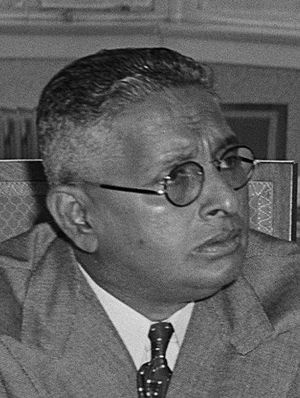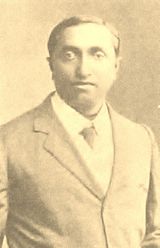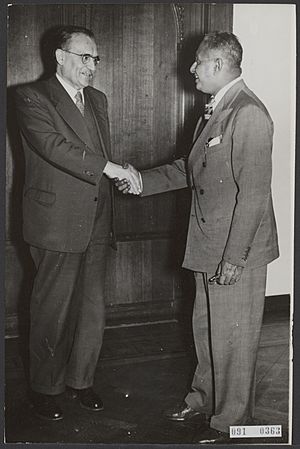John Kotelawala facts for kids
Quick facts for kids
General The Right Honourable
Sir John Lionel Kotelawala
|
|
|---|---|

Col. Sir John Kotelawala, c. 1951
|
|
| 3rd Prime Minister of Ceylon | |
| In office 12 October 1953 – 12 April 1956 |
|
| Monarch | Elizabeth II |
| Governor-General | The 1st Viscount Soulbury Sir Oliver Ernest Goonetilleke |
| Preceded by | Dudley Senanayake |
| Succeeded by | S. W. R. D. Bandaranaike |
| Minister of Defence and External Affairs | |
| In office 12 October 1953 – 12 April 1956 |
|
| Prime Minister | Himself |
| Preceded by | Dudley Senanayake |
| Succeeded by | S. W. R. D. Bandaranaike |
| Minister of Transport and Works | |
| In office 26 September 1947 – 1954 |
|
| Prime Minister | D. S. Senanayake Dudley Senanayake Himself |
| Succeeded by | Montague Jayawickrama |
| Member of the Ceylon Parliament for Dodangaslanda |
|
| In office 14 October 1947 – 5 December 1959 |
|
| Succeeded by | A.U. Romanis |
| Personal details | |
| Born | 4 April 1897 British Ceylon |
| Died | 2 October 1980 (aged 83) Colombo, Sri Lanka |
| Political party | United National Party |
| Alma mater | Christ's College, Cambridge, Royal College, Colombo |
| Profession | Politician, Soldier, Planter |
| Signature |  |
| Military service | |
| Allegiance | Ceylon |
| Branch/service | Ceylon Defence Force |
| Rank | |
| Unit | Ceylon Light Infantry |
| Commands | 1st Battalion, Ceylon Light Infantry |
General Sir John Lionel Kotelawala (born April 4, 1897 – died October 2, 1980) was an important leader from Sri Lanka. He served as the 3rd Prime Minister of Ceylon (which is now Sri Lanka) from 1953 to 1956.
Contents
Early Life and School Days
John Kotelawala was born into a rich family that owned land and mines. His childhood was tough because his father died when he was young. This also caused some money problems for his family.
He went to Royal College, Colombo, a famous school. There, he was very active in sports like cricket, tennis, boxing, and football. He even played in the big "Royal–Thomian" cricket match. He had to leave school because of events that happened in 1915.
After leaving school, he traveled around Europe for five years, even though World War I was happening. He spent most of his time in England and France. He studied agriculture at Christ's College, Cambridge.
John Kotelawala was known for being strong-willed and speaking his mind. He loved sports, especially horseback riding and cricket. When he was younger, he would sometimes get into fights if he felt insulted. He could speak Sinhala, English, and French very well.
When he came back to Ceylon, he became a planter. This meant he managed his family's farms and mines, including the Kahatagaha Graphite Mine. He also served as a Justice of the Peace, which is like a local official who helps with legal matters.
Military Service
John Kotelawala joined the Ceylon Defense Force in 1922 as a volunteer officer. He moved up in rank over the years. By 1933, he was a major. In 1939, he became the second-in-command of the Ceylon Light Infantry.
When World War II started, the Ceylon Defence Force grew bigger. John Kotelawala was the Minister of Communications and Works. This made him a member of Ceylon's War Council. He also led the Essential Services Labor Corp. He even let the wartime RAF station use his home, Kandawala, as an officers' mess. In 1942, he was given the special rank of honorary colonel. This was the highest rank a Ceylonese person could get in the Ceylon Defence Force at that time.
Political Journey
John Kotelawala came from a family that was very involved in politics. He started his own political career in 1931. He was elected to the State Council of Ceylon. Later, he became the Minister of Communications and Works.
Ceylon became an independent country in 1948. John Kotelawala was elected to Parliament. He became a member of the first government as the Minister of Transport and Works. He hoped to become Prime Minister when his uncle, Don Stephen Senanayake, who was the first Prime Minister, passed away. However, his cousin, Dudley Senanayake, became Prime Minister instead.
A year later, in 1953, he did become the third Prime Minister of Ceylon. He served until his political party lost the election in 1956. After that, John Kotelawala left politics and moved to Kent, England, for a while. He gave his home, Kandawala, to the government to be used as a defense university. Because of his long service, he was given the rank of General just before he died.
As Prime Minister
As Prime Minister, John Kotelawala's government kept some of the subsidies on rice. This led to a big protest called the 1953 Hartal. He was very against communism and took a strong stance against trade unions and left-wing political groups. He created special railway and communication units to keep things running if workers went on strike.
In April 1954, he welcomed Queen Elizabeth II and Prince Philip to Ceylon during their Royal Commonwealth Tour.
Under his leadership, Sri Lanka joined the United Nations. He also helped Sri Lanka build stronger relationships with other countries, especially in Asia.
Later Years
After losing the election, John Kotelawala stopped being involved in politics. He bought an estate in England where he lived for several years. Eventually, he returned to Ceylon. He hoped to become the Governor-General when the position became open. However, the Prime Minister at the time, Dudley Senanayake, chose to keep the current Governor-General, William Gopallawa, for another term.
His Passing
On September 29, 1980, John Kotelawala had a stroke at his home, Kandawala. He was taken to the hospital in Colombo. On October 1, the President, J. R. Jayewardene, visited him. The President gave him the special honorary rank of a General in the Army Volunteer Force. This was to thank him for his many years of service to the country. John Kotelawala, who was very ill, understood and accepted this honor.
He passed away on October 2, 1980, at the hospital. On October 5, his coffin was moved to Parliament House so people could pay their respects. His final ceremony was held at Independence Square with full military honors.
Family Life
John Kotelawala married Effie Manthri Dias Bandaranaike. Her mother was the sister of Don Stephen Senanayake. Their marriage did not last and they got divorced. They had one daughter named Lakshmi Kotelawala.
Sir John was known for his lively personality and for hosting many guests. He often entertained people at his home in Kandawala and his cottage in Nuwara Eliya. Even when he was Prime Minister, he chose to live at Kandawala.
His Lasting Impact
In 1985, a special defense academy was created at his estate, Kandawala. He had left his home to the country in his will so it could be used for this purpose. This academy trains officers for all three of Sri Lanka's defense services. It is now called the General Sir John Kotelawala Defence University (KDU). This university offers many courses for officers.
Statues of Sir John Kotelawala have been put up in different places across the island, including one near the Old Parliament Building, Colombo. Many schools, libraries, and public buildings are named after him. In 1993, the Sir John Kotelawala Museum was opened at Kandawala by the President.
Awards and Recognitions
Sir John Kotelawala received many awards and honors during his life. His medals and other special items are now on display at the General Sir John Kotelawala Defence University.
- Special Appointments
 Member of the Privy Council (1954) - This is a group of important advisors to the British monarch.
Member of the Privy Council (1954) - This is a group of important advisors to the British monarch.
- Honorary Military Ranks
 General of the Volunteer Force of the Army (1980)
General of the Volunteer Force of the Army (1980) Colonel of the Ceylon Defense Force (1942)
Colonel of the Ceylon Defense Force (1942)
- Awards and Medals
| Ribbon | Name | Year Awarded |
|---|---|---|
| Knight Commander of the Order of the British Empire (KBE) | 1948 | |
| Order of the Companions of Honour (CH) | 1956 | |
| Knight of Justice of the Most Venerable Order of the Hospital of Saint John of Jerusalem (KStJ) | 1965 | |
| Defence Medal | 1945 | |
| War Medal 1939–1945 | 1945 | |
| King George V Silver Jubilee Medal | 1935 | |
| King George VI Coronation Medal | 1937 | |
| Queen Elizabeth II Coronation Medal | 1952 | |
| Efficiency Medal (Ceylon) | 1949 | |
| Ceylon Armed Services Inauguration Medal | 1955 | |
| Knight Grand Cross of the Légion d´honneur (France) | 1954 | |
| Order of the Rising Sun, 1st Class (Japan) | 1954 | |
| Knight Grand Cross of the Order of Merit of the Italian Republic (Italy) | 1954 | |
| Knight Grand Cross 1st Class of the Order of Merit of the Federal Republic of Germany (Germany) | 1955 | |
| Knight Grand Cross of the Order of the White Elephant (Thailand) | 1956 | |
| Knight Grand Cross of the Order of the Netherlands Lion (Netherlands) | 1956 | |
| Ceylon Armed Services Long Service Medal | 1980 | |
| Republic of Sri Lanka Armed Services Medal | 1980 | |
| Sri Lanka Army 25th Anniversary Medal | 1980 |
- University Degrees
 Honorary Doctor of Laws (LLD) from University of Ceylon
Honorary Doctor of Laws (LLD) from University of Ceylon Posthumous Doctor of Laws (LLD) from General Sir John Kotelawala Defence University
Posthumous Doctor of Laws (LLD) from General Sir John Kotelawala Defence University
Images for kids
-
Sir John Kotelawala as Minister of Transport visiting at Amsterdam Airport Schiphol in 1951.








